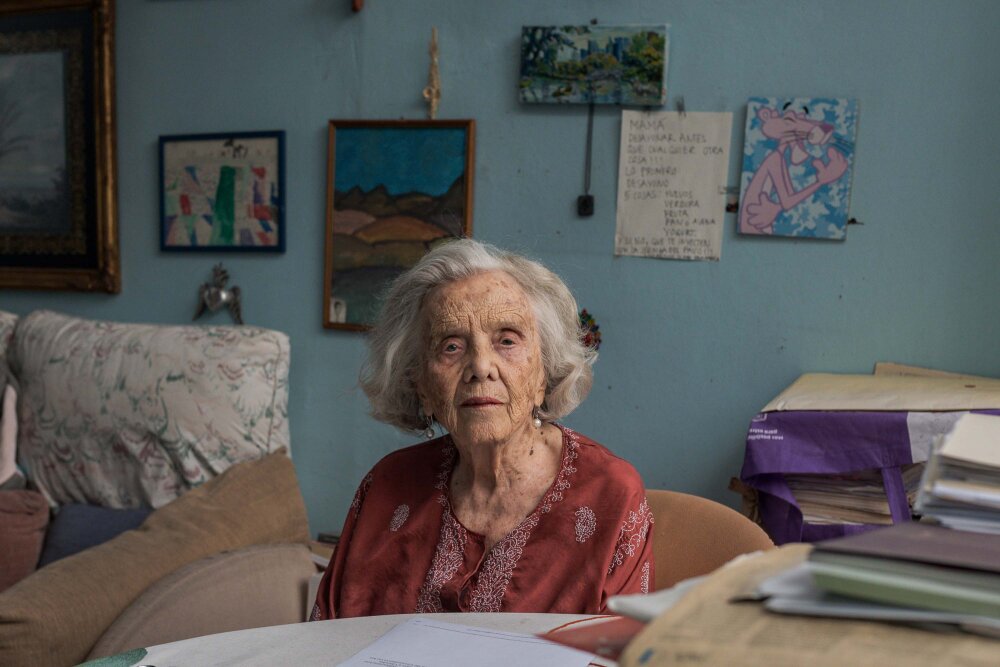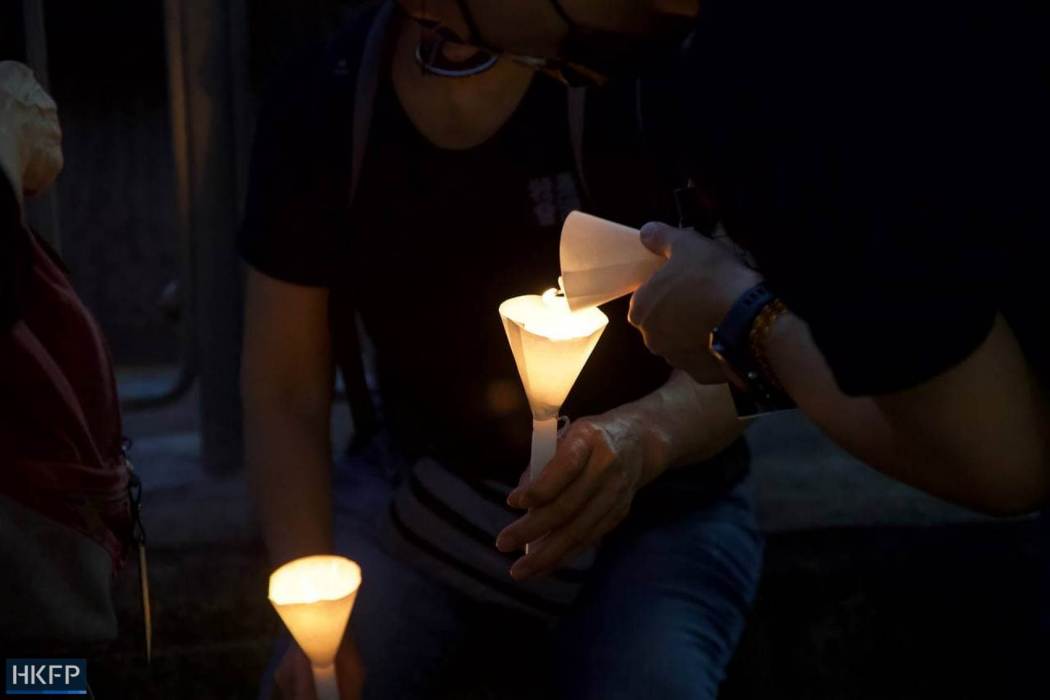Country:
INDIA
Authors:
Shagun Kapil
GRANTEE
Joel Michael
GUEST CONTRIBUTOR
Project
No Escape From Heat for India’s Vulnerable Workers
From L-R, Construction worker Rohit Kumar Paswan, boiler plant worker Bhim Singh
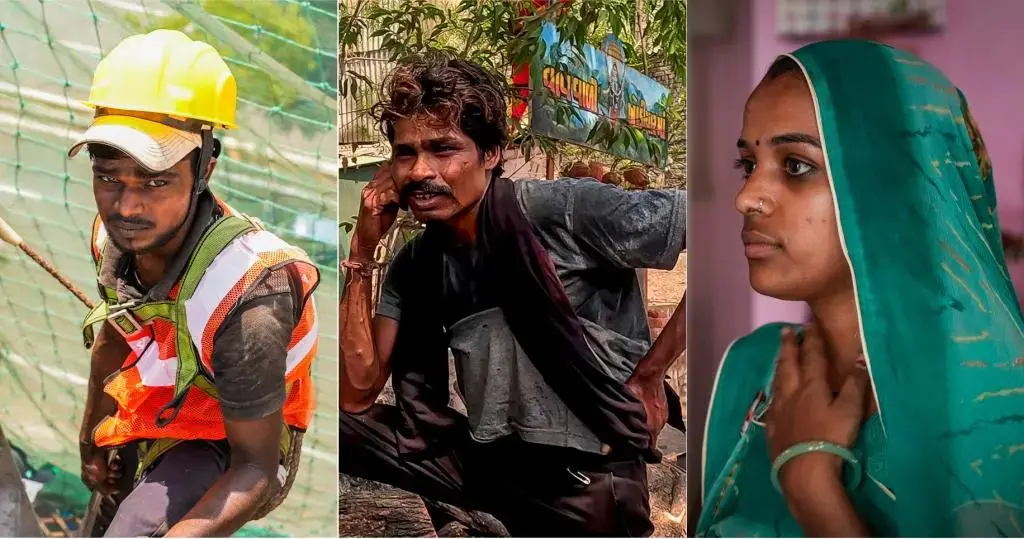
In part one of this series, DTE investigates how the new normal of extreme heat is impacting informal workers and workplaces lacking climate control mechanisms
Rohit Kumar Paswan’s daily job involves securing himself to a harness and ascending scaffolding on the 10th floor of a building under construction, with the mercury soaring to around 47 degrees Celsius.
Bhim Singh works inside a boiler plant that operates a textile unit.
Kajalben spends a significant portion of her day within her cramped house, operating a sewing machine to stitch clothes for her customers.
All three work in different occupations, in distinct workspaces — the first is directly exposed to the sun during his working hours, the second works within a factory and the third from the comfort of her own home. However, a common factor binds them in their workplaces: Extreme, intense heat is unavoidable for all three.
Video courtesy of Down To Earth. India, 2024.
Down To Earth’s (DTE) Shagun and Joel Michael travelled to brick kilns, construction sites, factories, small-scale units and homes serving as workplaces for thousands of informal workers in Delhi, Haryana, Uttar Pradesh (UP) and Gujarat to understand how a rapidly warming planet has made work extremely challenging, testing people’s tolerance limits.
Around 82 per cent of India’s workforce is engaged in the informal sector and nearly 90 per cent is informally employed.
This new series by DTE will report on how heat is affecting labourers and workplaces that lack climate control mechanisms like cooling or air conditioning, or where these systems cannot be implemented due to the nature of the work. The reports will also examine the health impacts heat has on the most vulnerable populations, along with possible prevention measures that industries can explore.
In the first part of the series, DTE reports on outdoor workers who build our cities but are directly exposed to the scorching heat.
“MY BODY FEELS like it is trapped in a heat island, soaked in sweat. I would choose any other job over this if given the choice,” 34-year-old Biresh Kumar described his daily job, which entails working directly under the sun’s rays for four hours (from 8 am to 1 pm) and then for another two hours after a break (1-3 pm).
Kumar works at a brick kiln in Bhopani village in the Faridabad district in Haryana, part of the Delhi-National Capital Region (NCR). He prepares clay from soil and crafts raw bricks in the open, under the sun. These bricks must be sundried before firing in the kiln.
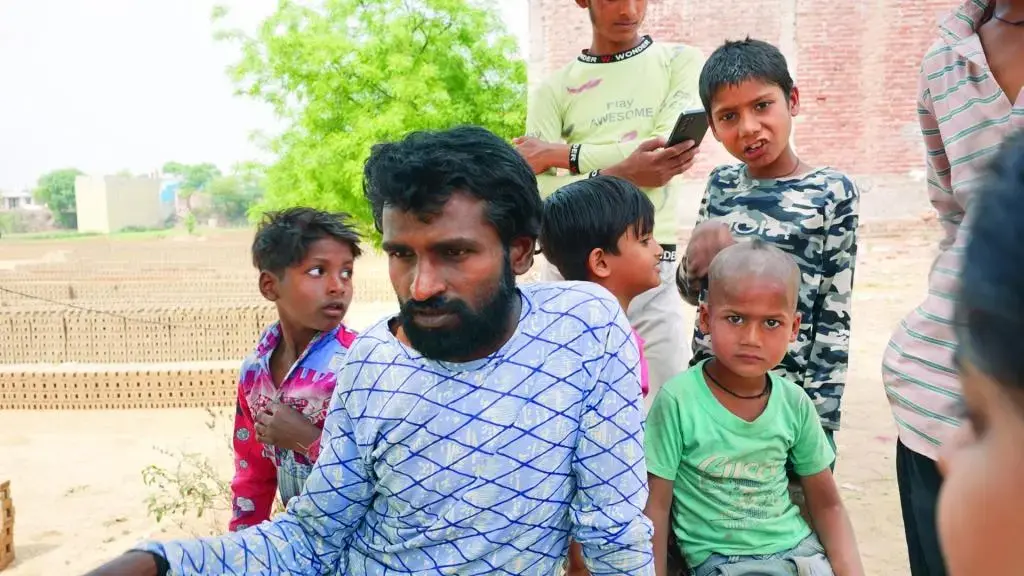
Brick kiln worker Biresh Kumar. Image by Joel Michael/CSE. India, 2024.
DTE first met him in mid-April and recorded the area’s surface temperature using a ‘particle counter’ instrument, which measures air temperature, relative humidity and wet bulb (WB) temperature, among other factors. The temperature reading of the area where he works was 38.4°C.
WB is the lowest temperature to which air can be cooled by evaporating water at a constant pressure.
Workers in brick kilns are subjected to both extreme ambient temperatures and intense radiant heat from the kilns where the bricks are fired. “A person cannot walk for more than an hour in the sun and here our work entails continuously working under it. My job requires me to squat for most hours while making the bricks, which leads to knee pain and reduced blood circulation to the lower limbs,” he said.
This is Kumar’s first year working at a brick kiln. A native of Hathras district in the neighbouring UP, he owned a juice shop in Rajasthan’s Sri Ganganagar town until 2020, when he had to close it down during the COVID-19-induced lockdown.
The shop was rented. As Kumar was unable to afford the monthly rent in the pandemic, he and his family of five (wife and three children) had to relocate to their hometown in UP, with no savings and no source of income.
There, he encountered the contractor of the brick kiln, who offered him a non-institutional loan in exchange for his labour. The family accepted the advance and arrived in Faridabad in February 2024 to commence work at the kiln.
Sitting on a cot at some distance is Kumar’s co-worker, Somveer (he only provided his first name). For two days, Somveer was experiencing body aches, weakness and fever, forcing him to miss work and consequently forfeit his wage. He was unsure of the exact cause of his condition but suggested it could be due to heat exhaustion.
Neeraj Kaushik, the medical officer in charge of the Government Hospital (Community Health Centre) in Faridabad's Kheri Kalan, which is accessible to Somveer and Kumar, said he noticed an increase in the number of brick kiln workers presenting to the hospital with complaints of dehydration and fainting episodes.
“We see more such patients in the months of May and June. Sometimes they are severely dehydrated, have dry lips and are extremely weak, so we have to instantly administer rehydration fluids. For those with co-morbid conditions like diabetes, it becomes an emergency situation when their vitals are disoriented and then it takes a lot of time to revive them,” he said, pointing out that the patients were mostly people working in brick kilns, construction sites and agricultural farms.
India in grip of heatwave
On May 24, when DTE revisited two brick kilns (including the one where Kumar and Somveer work), the device recorded a temperature of 43°C at the site, with a relative humidity of 38.5 per cent and a WB temperature, which indicates both temperature and humidity, of 30°C.
India’s northern, northwestern and central regions are in the grip of a relentless heatwave, with temperatures even surpassing 50°C in some areas of Rajasthan, Haryana and Delhi on May 28. India Meteorological Department (IMD) defines a heatwave threshold as when the maximum temperature reaches 40°C in the plains, 30°C in hilly areas and 37°C in coastal areas, with a departure from the normal maximum temperature of at least 4.5°C.
The IMD, in its forecast, stated that there is a “very high likelihood of developing heat illness and heatstroke in all age groups.” According to media reports, there have been 11 deaths due to suspected heatstroke in the state of Rajasthan and two in Gujarat.
How hot is too hot to work?
The recommendations by National Institute for Occupational Safety and Health in the United States permit continuous work at heavy intensities in hot environments up to 34°C and 30 per cent relative humidity.
The year 2024 has witnessed every month breaking global heat records since the pre-industrial era. It commenced with Earth experiencing its warmest January since records began in 1850, followed by the hottest March and now May 2024 is poised to become the 12th month to continue the streak of record-breaking temperatures.
Climate change and the El Nino phenomenon have significantly contributed to this record-shattering heat surge across Asia, including India, as analysed by an international team of 13 leading climate scientists from the World Weather Attribution group in a global study on May 15, 2024.
While intense heat driven by climate change remains relentless worldwide, individuals engaged in heavy physical labour are particularly at risk as their work exposes them to greater heat stress.
In addition to brick kiln workers, outdoor labourers also include agricultural workers performing heavy physical labour in heat, construction workers, gig workers, autorickshaw drivers, street vendors, among others, who are more exposed due to the nature of their work and challenging economic conditions.
“My first visit to a brick kiln was as a child, 20 years ago, with my father (who worked at one of them). I used to play around then. Even then, work lasted from morning to evening, but there was less heat. There is a big difference between then and now,” said Kumar.
Similarly, Somveer has been working in various brick kilns for six years, but in the last two to three years, he claimed, the heat has tested his body’s tolerance level. “This work used to feel normal just two years ago,” he said.
Both make around 2,500 bricks a day on average and receive Rs 520 ($6.26) per 1,000 bricks. However, the number of bricks they produce decreases as temperatures peak.
India is projected to lose 5.8 per cent of working hours in 2030, a productivity loss equivalent to 34 million full-time jobs, due to global warming, the International Labour Organization (ILO) estimated in its 2019 report. As a result, this will lead to a loss of income and livelihood for informal workers, who are most vulnerable to extreme and intense heat.
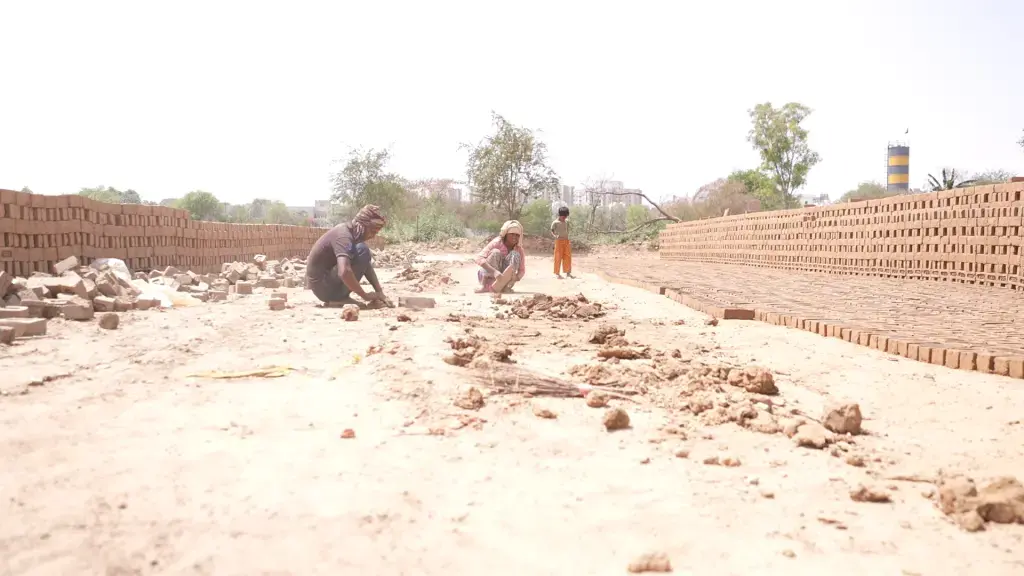
A brick kiln in Bhopani village, Haryana. Image by Joel Michael. India, 2024.
According to World Bank estimates, nearly 75 per cent of India’s workforce, or 380 million people, depend on heat-exposed labour.
A study conducted in brick kilns in Chennai in 2013 and 2014, published in 2019, found that occupational heat exposure in the kilns during the summer months sometimes exceeded international standard limits for safe work.
Kumar and Somveer are just two of the nearly 440 million people employed in India’s unorganised sector, as per the Economic Survey 2021-22. But they both exemplify how work has not only been disrupted by excessive heat but now feels almost like an intolerable punishment.
Brick manufacturing is a highly labour-intensive industry. Large numbers of workers are employed at each stage, including moulding bricks, transporting sundried and baked bricks to the kiln, adding fuel to the kiln and removing bricks once they have cooled to transport them further.
In May, the work of moulding and transporting bricks at the brick kiln sites was moved to night-time. However, night-time temperatures have also increased substantially, along with humidity. Additionally, mosquito bites increase at night. The IMD, in its May 24, 2024 forecast, cautioned that warm night conditions could also intensify in different parts of northern India.
The workers in charge of firing the kiln and ensuring that the bricks are adequately burned, on the other hand, are not permitted to change their schedules because this is a 24-hour job. Kilns in Delhi-NCR start up on March 1 and only shut down when the monsoon arrives in mid-June.
Those working in the third stage (fuelling the kilns) are constantly exposed to sunlight and additional heat from the furnaces inside the kiln. The chambers that feed the fuel (husk in this case) and burn the bricks at temperatures ranging from 1,100°C to 1,200°C produce scorching heat. Temperatures in the area where bricks are baked rise significantly when compared to other areas on the site.
Video courtesy of Down To Earth. India, 2024.
At one of the two kilns visited by DTE on May 24, a group of seven dedicated ‘firemen’ continuously fed fuel into each chamber. DTE recorded a temperature of 48°C and a WB temperature of 30.3°C at 3.30 pm. There was a temperature difference of 2°C just 200 metres away, where it was around 46°C.
How hot does it feel to the workers? “Crossing 50°C,” said Rajendra Kumar, who works with six others in two shifts from 1 pm-7 pm and 1 am-7 am, for Rs 600 ($7.22) per day. Out of these 12 hours, a total of six hours are spent near the chamber. Of these six hours, three are during the daytime. This means that for at least three hours of their day shift, the group is exposed to extreme temperatures continuously.
Most men stay away from their families. “Yahan aayenge gharwale? Marna hai kya? (Why will they come here? Do they want to die?),” said Rajendra rhetorically.
India is the second-largest brick producer in the world, with the sector producing 233 billion bricks each year and employing about 23 million people, who are at risk of extreme heat exposure. The brick industry is growing, with the demand for bricks increasing due to rapid urbanisation and the growing number of construction projects in the country.
Infrastructure boom and heat conundrum
Madhu Mandal wonders if he will ever find a workplace where he can escape the heat. It is around 1 pm on a blazing hot day in the national capital, Delhi. Mandal and his wife work as masons at a construction site along one of the stretches of the Dwarka Expressway.
Construction work is progressing rapidly on the eight-lane expressway, which is being developed as a residential and commercial hub and has seen a massive transformation over the last 10 years, with high-rises, gated communities and retail hubs dotting the 29-kilometre highway. The Mandals, natives of Katihar district in Bihar, are working on one such high-rise.
The brick kiln sector supports the rapidly expanding construction industry, which is projected to grow at a compound annual growth rate of six per cent from 2024 to 2033, fuelled by the government’s infrastructure push and rapid urbanisation.
Construction workers like Mandal are the backbone of this economic activity in India. The sector is the second largest employer in India, next only to agriculture, employing nearly 74 million workers, according to the National Sample Survey Office 2016-17.
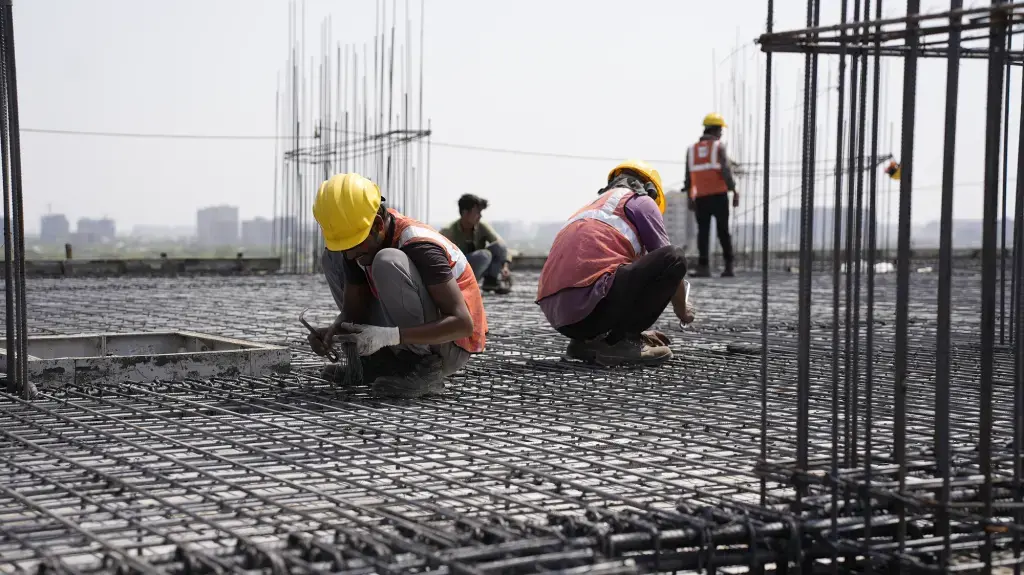
Construction work in Ahmedabad. Image by Joel Michael/CSE. India, 2024.
Scientists have said that heatwaves are not only here to stay but will intensify in the coming years. In a country where approximately 50 per cent of gross domestic product or GDP is contributed by workers who work in heat-exposed conditions, are there enough safety measures?
Mostly, no. For example, Paswan, a construction worker in Ahmedabad city in the state of Gujarat, has been requesting his manager to install a green net on the top floor of an under-construction shopping mall where he works, but to no avail.
He has to work in a scaffolding operation, which involves standing for long hours at a height. When he takes a break, he looks for a place with some shade. “But for that, we have to go downstairs, which is a challenge. We have been telling the managers to arrange for a green net somewhere on the top floor where we work,” he said.
Temperature readings at different sites at an outdoor workplace showed that in a shaded area, the temperature gets reduced by a good 3-4°C, compared to the open area. Thus a simple solution like putting up a green net, making a shaded area that will block direct sunlight, or having more green spaces just near where the workers spend their time working, will allow them to cool down their bodies and have a proper rest during their breaks.
Illustration by Yogendra Anand. Interactive design by Ritika Bohra.
A recent study by the Delhi-based think tank Centre for Science and Environment (CSE) showed that enhancing green spaces can cool down temperatures by as much as 5°C and up to a distance of more than 250 metres. When DTEmet Paswan in mid-May, the temperature was 46.7°C, with a WB temperature of 31.2°C.
“I start work at 8 am and just after 10 am, I start feeling the heat. After 10 am, I feel like taking a break every 20-30 minutes,” said 22-year-old Paswan.
However, his job involves clipping himself to a harness and treading the scaffold, so he cannot take breaks often. “There are moments in the day when the body just wants to stop and rest,” he said.
According to a study by National Institute of Occupational Health-Indian Council of Medical Research in Ahmedabad with 29 young male construction workers, heat exposure at the construction workplace during the summer months was very high, with WB globe temperatures reaching 33°C. This exceeds the international standard limit values for moderate level work activities in a hot environment, which are set at 30°C.
Among all the hazards exacerbated by climate change, heat is undoubtedly a major disaster that will become more intense. Disaster risk must be considered during a country’s development, said Abhiyant Tiwari, lead, health and climate resilience at Natural Resources Defense Council India.
“At the rate we are urbanising, almost 70 per cent of infrastructure is yet to be built for the future and it has to factor in the rate of warming we are facing across the world, particularly in the Global South. If we do not consider that, we will fail drastically,” said Tiwari, who was part of the development and implementation of the first heat action plan of South Asia in 2013.
This calls for India to seriously include the ‘heat factor’ in its work policies. Are the workers that build and run our cities at the centre of climate change? Are governments, companies and civil society considering heat in their workplaces and seeking real-life adaptation solutions? The second part of the series will explore these questions.

As a nonprofit journalism organization, we depend on your support to fund more than 170 reporting projects every year on critical global and local issues. Donate any amount today to become a Pulitzer Center Champion and receive exclusive benefits!






